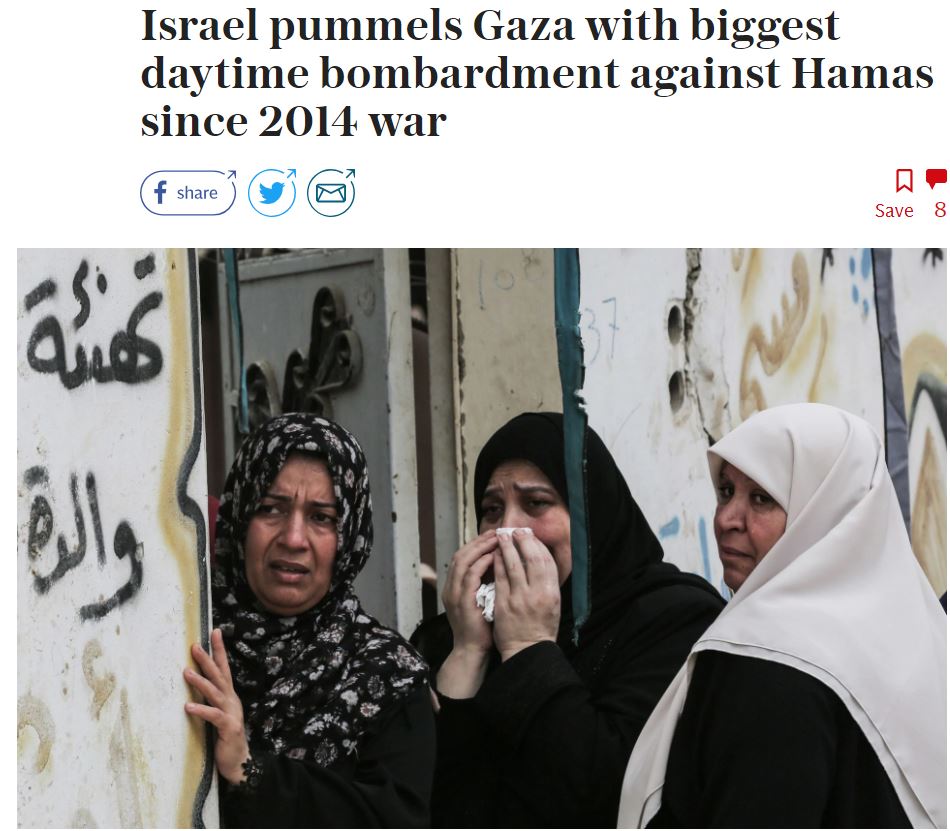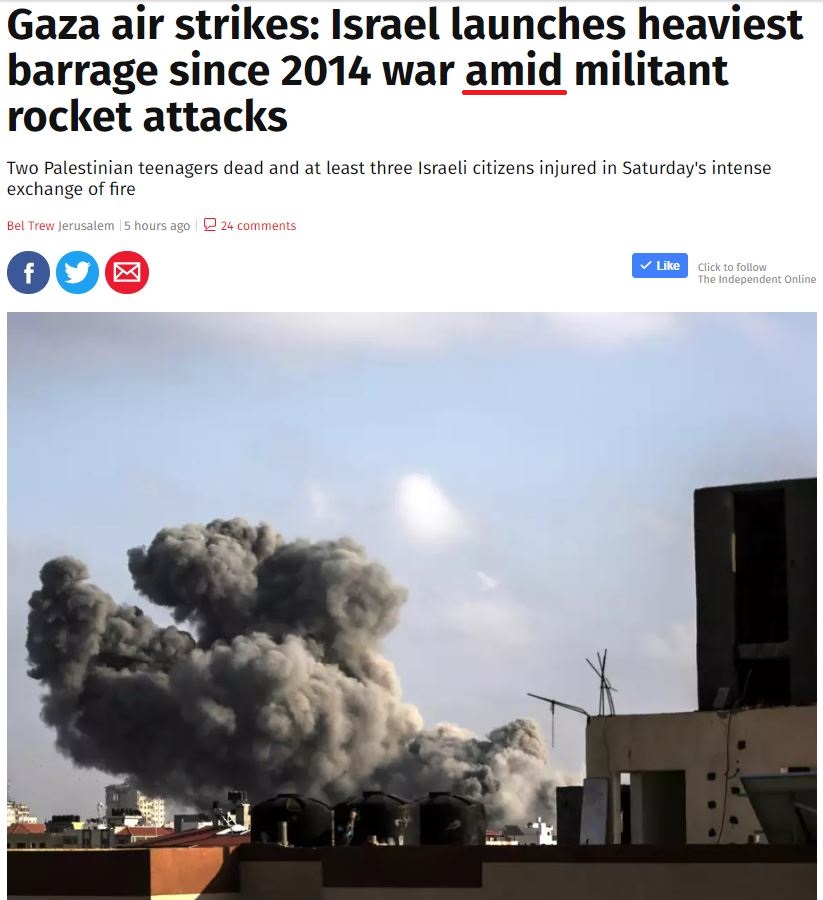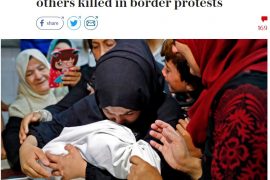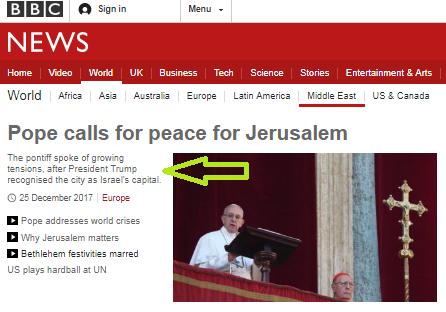British media outlets published reports on the latest violence between Israel and Gaza terror groups, characteristically muddling the sequence of events by highlighting the Israeli response to Gaza terror, whilst downplaying or ignoring completely the terror itself.
Here’s what occurred.
On Friday night, an Israeli soldier was moderately wounded by shrapnel from a grenade lobbed at him from the northern Gaza Strip during violent riots by thousands of Palestinians at the border.
Early on Saturday morning, the IDF attacked sites used by Palestinians to build and distribute incendiary kites – bombs which have caused thousands of fires and destroyed over 7,400 acres of land, context regarding the current tensions between Israel and Gaza largely ignored by the media.
Israel’s air force also bombed two attack tunnels near the border.
Later Saturday morning, terrorists fired scores of rockets on Israeli communities in the south, forcing thousands to flee for bomb shelters, and included a direct hit on a home in Sderot, injuring four members of the same family.
In response, the IDF launched “its largest bombing campaign against Hamas targets…since the 2014 Gaza war” hitting dozens of military sites. More rockets were fired from Gaza late Saturday night, but a ceasefire, negotiated by Egyptian intelligence and the UN secretary-general’s envoy to the region, slowly took hold.
So, to summarize:
- The ongoing Hamas kite bomb campaign, which cause up to 20 fires in Israel a day, continued.
- Ongoing, Hamas inspired, Palestinian violence at the Gaza border continued on Friday, and included a grenade attack which injured an Israeli soldier.
- IAF launches a limited number of attacks on Hamas military positions in response to the grenade attack.
- Hamas and Islamic Jihad launched nearly 200 rockets at Israeli communities along the south, injuring three civilians.
- IAF launch over 40 attacks on Gaza military positions, including a direct hit on a Hamas battalion command in northern Gaza, which was completely destroyed – though fighters had evacuated the position and nobody was killed.
Here’s a quick run down of the headlines. Some failed to convey the accurate sequence of events, whilst others actually ignored entirely the Gaza terror attacks which precipitated the violence.
There’s no mention, in the headline or strap line, of the initial Hamas rocket attacks or the grenade attack on Friday. The image depicts an attack on Gaza, rather than rocket attacks on Israel.
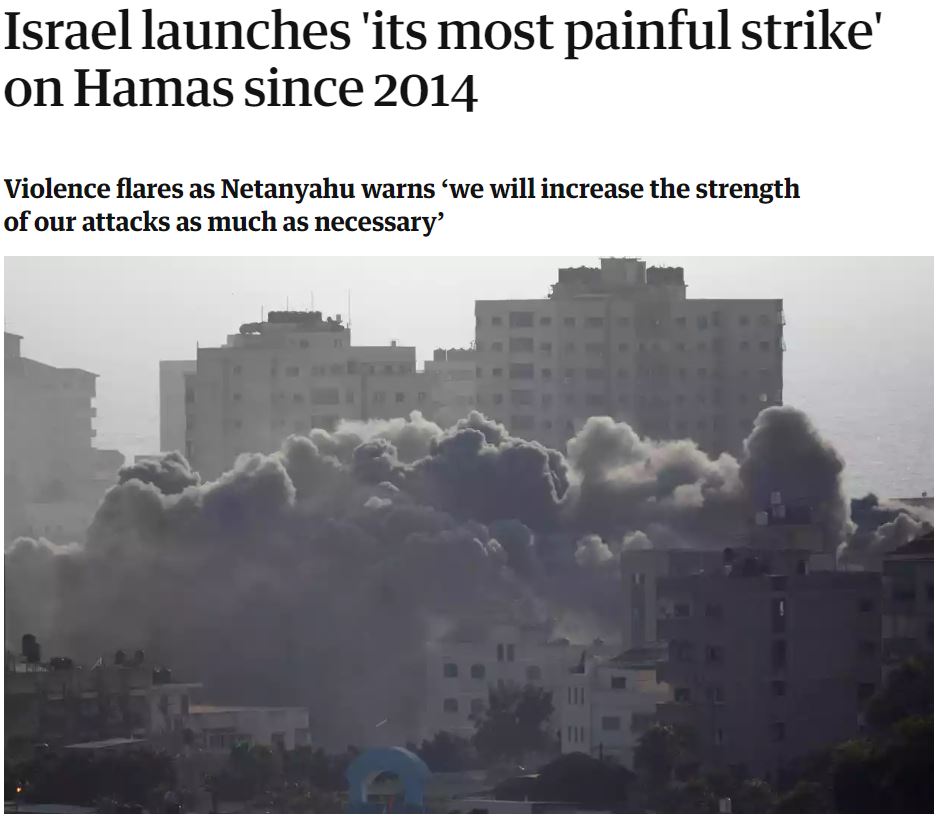
Also of note: The article was by Associated Press, but Guardian editors changed AP’s original headline (“Israel exchanges intense fire with Hamas militants in Gaza”) which was much more fair in noting the exchange of fire between both parties, not merely the Israeli response.
There’s no mention whatsoever in the headline of the Hamas rocket attacks.
Also, the image actually depicts women in Gaza grieving the death of a Palestinian teen who participated in violent riots on Friday along the border, and isn’t related to the IDF’s subsequent bombardment of military targets in Gaza on Saturday.
Though the article itself actually gets the sequence of events correct, the headline and photo focus entirely on the Israeli response to Hamas attacks.

This headline is better than the Guardian, Telegraph and Times of London as it actually notes the Gaza rocket attacks.
The image, however, depicts an Israeli attack on Gaza, rather than the damage done by rockets to Israeli communities.
More of the same, with the headline and photo focusing entirely on Israel’s response to Gaza terror.

Sky showed, without context, an IDF video showing an attack on military targets in Gaza. There’s no mention of terrorist rocket attacks on Israel, nor any context whatsoever.
Most outlets illustrated their articles with photos that focused entirely on the damage in Gaza, and Palestinian suffering, despite a plethora of images and videos shared on social media showing damage to Israeli civilian communities from the rocket attacks.
Here are a few:
An Israeli family takes cover in a stairwell amidst Hamas rocket attacks.
An Israeli man in Sderot injured by rocket shrapnel.
The house in Sderot hit by a Hamas rocket:
Israeli man narrowly escapes rocket.
Hamas rocket hits playground in Sderot.
Summary:
- 5 headlines failed to mention Gaza rocket attacks.
- 6 featured a photo of damage in Gaza from IAF strikes.
- 0 used images, anywhere in the article, of damage done by Hamas rockets.
- 6 failed to note it was the largest volley of Hamas rockets since 2014.
One final note about the headline choices. Editors focused on the fact that the Israeli attack on military targets Saturday was the “heaviest barrage” by the IDF since the 2014 war. However, it’s quite telling that they decided not to focus on the fact that the nearly 200 rockets fired at Israel on Saturday represents the single largest volley of Gaza rockets launched on any single day since the 2014 war.
So, headlines which read “Israel pummels Gaza with heaviest bombardment since 2014” could just as easily have read: “Gaza pummels Israel with heaviest bombardment since 2014”.
The broader dynamic at play is the consistent failure of journalists and their editors to frame articles in a manner which focuses primarily on terrorist violence and evokes sympathy for Israeli terror victims and the southern communities on the receiving end of such attacks. The story they wish to tell demands that the words and images be molded to conform to the desired ‘David vs Goliath’ narrative. It also operates from an assumption that Palestinians lack agency and that the only party in the conflict that matters is Israel.
The facts may change, but the story remains the same.


